| Srl | Item |
| 1 |
ID:
127347
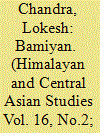

|
|
|
| 2 |
ID:
100871
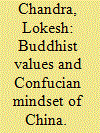

|
|
|
| 3 |
ID:
141382
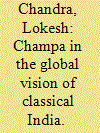

|
|
|
|
|
| Summary/Abstract |
The foundation and flourishing of Champa on the major marine trade route from Kanchi to Canton, or from the SE Asian isles to Canton, was part of a new historic phenomenon of the fast emergence of cultural kingdoms from tribal orders. The new paradigm was the empowerment of the dormant energy of the non-alphabetic tribes by enriching them with a writing system and thinking patterns; establishing kingdoms with a king, ministers, nobility and State functionaries; setting up palaces and temples; the rise of an intellectual class and priestly orders. Emperor Asoka sought the substitution of war drums by the drums of Dharma, bherighosa became dhammaghosa. He initiated this process of culturation by sending his son Mahendra and his daughter Sanghamitra to Srilanka by deputing his ministers to Khotan and crowning his son as the first “King of Khotan,” by planning his son Kunala to be the King of Kucha, and so on. This sowing of intellectual seeds in the immensity of the regions was the rise of a new order of a spiritual culture and secular civilisation in the whole of Asia. The theodiversity, pluralism of life styles, alongwith an organised state, economy and strategic systems of India became the dawn of a new age in the SE Asian region upto mainland China. Indian savants, princes and merchants envisioned Suvarnadvipa in their quest of affluence of life.
|
|
|
|
|
|
|
|
|
|
|
|
|
|
|
|
| 4 |
ID:
138665
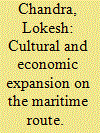

|
|
|
| 5 |
ID:
108894
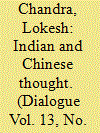

|
|
|
| 6 |
ID:
077829
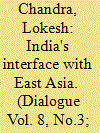

|
|
|
| 7 |
ID:
031045
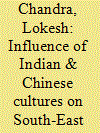

|
|
|
|
|
| Publication |
New Delhi, Free News and Feature service, 1970.
|
| Description |
11p.
|
|
|
|
|
|
|
|
|
|
|
|
Copies: C:1/I:0,R:0,Q:0
Circulation
| Accession# | Call# | Current Location | Status | Policy | Location |
| 006710 | 306.2091724/LOK 006710 | Main | On Shelf | General | |
|
|
|
|
| 8 |
ID:
088654
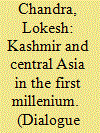

|
|
|
| 9 |
ID:
142381
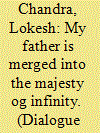

|
|
|
| 10 |
ID:
060343
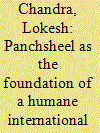

|
|
|
|
|
| Publication |
Oct-Dec 2004.
|
|
|
|
|
|
|
|
|
|
|
|
|
|
|
|
| 11 |
ID:
131850
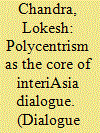

|
|
|
|
|
| Publication |
2014.
|
| Summary/Abstract |
The twentieth century was wrapped in gold plundered from a thousand flowers. It was consumerism at its height. It clothed the mind with physicality. This century seeks inner steppes, immense and pristine. We have to work out a journey to the innermost substance of being. People of Asia have to enshrine their vision and value in ever-creating, all-irradiating forms. We have to avoid to avoid the tragedy of becoming non-descript and monocentric, deprived of roots.
|
|
|
|
|
|
|
|
|
|
|
|
|
|
|
|
| 12 |
ID:
135716
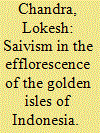

|
|
|
|
|
| Summary/Abstract |
The seventy-five glorious years of the Bharatiya Vidya Bhavan have been the heaven and jasmine of its founder and his clarion call of Jaya Somanatha, to bloom the cultural dreams of a renascent India, to unveil the shining peaks of our minds over the millenia. The noble vision of Kulapati Munshi became embedded in the Bhavan to keep alive the light on the horizons of history, and angelic in the wrappings of life: can flowers forget the spring? It is in tune with the founding spirit of the Bhavan to celebrate its platinum jubilee with a symposium on Abhinavagupta the great master of the Trika philosophy of Kashmir, who also formulated a new theory of aesthetics. A few weeks before Kulapati Munshi ascended the Heavenly Fields of eternal Vrindavana beyond the plane of duality, I was in Mumbai and went to see him. He lay on his couch, with his charming consort Leelavati sitting beside him. I began with an interpretation of his historic noval Jaya Somanatha. Somnatha was a temple dedicated to Lord Śiva as the Lord of the Moon, as the guardian of trans-oceanic merchants. The waxing and waning of the Moon has fatal effects on the waves of the oceans which toss the ships in deadly turbulence. The Jātakamālā of Āryaśūra recounts the voyage of the seasoned steersman Supāraga when the sea took a terrible aspect all of a sudden: like the earth quivering with her mountains at the time of world destruction. The sea rose up in rage, saddening the hearts of the occupants Supāraga refers to Sopara seaport in Gujarat. Just as Śiva lessened the impact of the torrents of the Gangā descending to earth, so does' He mitigate the tumult and turbulence, the Sturm und Drang, caused by the Moon (Soma). As Lord of the Moon, as Soma-nātha, he blesses marine travel with safety and assurance. Somnath was a Temple of Mariners, and even Arab merchants made offerings for safety and success in their trade. The renown of the extravagant riches of Somnath spread all over the lands of trans-national trade, whether Alexandria, Iraq, Iran or Central Asian kingdoms. Its immense oppulence attracted greed and fundamentalism in 1024AC when it was sacked after a fiercely contested battle in which fifty thousand defenders were killed and the invaders returned with a huge booty.
|
|
|
|
|
|
|
|
|
|
|
|
|
|
|
|
| 13 |
ID:
117082
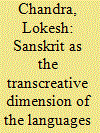

|
|
|
| 14 |
ID:
129406
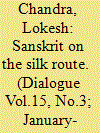

|
|
|
|
|
| Publication |
2014.
|
| Summary/Abstract |
Sanskrit was the mind of Sill: Route, at one with the sky-void and the spring mist, the live hues of sensibility dyed in eternity. a bridge of dreams floating across eloudless skies of the sands, a symbol system that made the heart pure, the spring blossoms of the devout. It was the realisation of Truth, and the very being of Values. Sanskrit was to enter the profound, the inner depths. Today. torn Sanskrit fragments
from the silk Route reflect the savagery of fundamentalism. the furious wrath of apostasy. They remind me of ten million Buddhist Sutras being mthessly committed to fire in Buryatia. Mongolia. Kalrnykia.
and Tuva. As Lama Sandaa related to me with tears ?owing across his withered face of eithty years: 'I was forced to destroy what I revered, admired and had faith in. There's no torture more terrible than that'.
Likewise. these Sanskrit fragments are tears of time. Scholars sit in their silence, forgetting the hours that follow each either, to identify tiny and large feagments as if perfecting a diamond. They are ratnaktita or heaps of jewels in the words of Prof. Karashima. We are pilgrims to amazing centuries that have ?ourished and vanished.Vedic Shaivism
|
|
|
|
|
|
|
|
|
|
|
|
|
|
|
|
| 15 |
ID:
117154
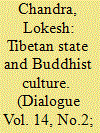

|
|
|